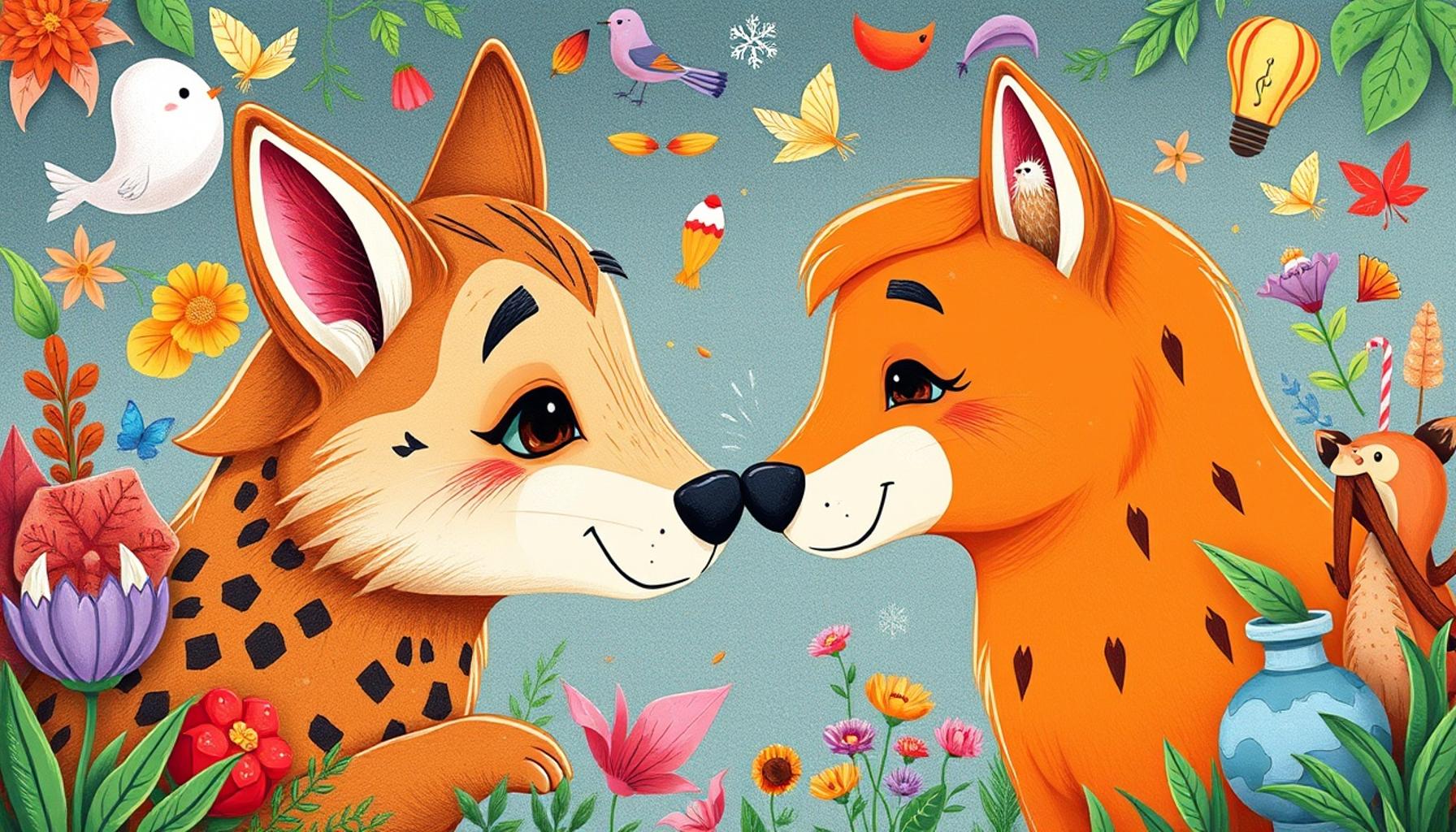The Influence of the Family Environment on Pet Behavior

Understanding the Core Factors
Our pets are not just animals; they are integral members of our families. The way they behave and interact often reflects the atmosphere and dynamics of the home environment they grow up in. Numerous studies reveal how family structures, interaction styles, and even daily routines can shape a pet’s behavior. Understanding these influences can dispel some common misconceptions about pet behavior and help foster healthier relationships between pets and their owners.
Key Influencing Factors
Several aspects of the family environment directly influence pet behavior:
- Family Dynamics: The relationship between family members can significantly affect a pet’s sense of security and comfort. For instance, pets living in harmonious households where family members exhibit affection and respect towards each other tend to be more relaxed and well-adjusted. Conversely, pets in homes characterized by conflict or inconsistency may exhibit aggression, anxiety, or fear. It’s not uncommon for pets to develop heightened senses of stress due to the emotional climates in which they are raised, illustrating the impact of their human companions’ relationships on their behavior.
- Socialization Practices: How pets are introduced to various situations, people, and other animals can determine their social skills. Early exposure, particularly during the critical early months of a pet’s life, is crucial. For example, puppies and kittens that are positively exposed to diverse experiences—like meeting new people and fellow pets, navigating different environments, and experiencing routine veterinary visits—tend to grow into well-adjusted adults. In contrast, those that are isolated may develop fearful or aggressive tendencies that can limit their social interactions throughout their lives.
- Consistency and Routine: Pets thrive on predictability, making a consistent routine vital for their emotional stability. Daily feedings, regular walks, and set playtimes help pets feel secure, reducing anxiety and promoting positive behaviors. For example, a dog accustomed to a morning walk followed by breakfast will likely feel more at ease in its surroundings, knowing what to expect from its day. On the other hand, a disrupted routine can lead to confusion and stress, often manifesting as misbehavior or anxiety-related issues.
Moreover, the type of family—be it single-parent households, multigenerational families, or child-free couples—also plays a significant role in shaping how pets respond to their owners and the world around them. Single-parent households may foster a close bond with pets due to increased interaction, while multigenerational families often provide a busy, vibrant environment that can enrich a pet’s life. Compared to child-free couples, which may offer quieter routines that allow for a different kind of bonding experience. In the United States, where diverse family structures exist, understanding these influences can help us create a nurturing environment that promotes positive behavior in our pets.
The key takeaway is that pet owners can foster better connections and understanding with their pets by being mindful of these core factors. By investing time in nurturing family dynamics, adopting thoughtful socialization techniques, and establishing consistent routines, we can significantly enhance the well-being and behavior of our beloved furry companions.
DISCOVER MORE: Click here to learn how pets can boost your mental well-being

Family Environment and Its Impact on Behavior
The family environment is a significant determinant of pet behavior, and understanding this connection is essential for any pet owner. A harmonious home can foster not only emotional health but also behavioral stability in pets. Recent research highlights the intricate interplay between family dynamics and pet behavior, showcasing how various factors can create a nurturing atmosphere for our furry friends.
The Role of Positive Reinforcement
The influence of positive reinforcement cannot be overstated when considering how family members interact with their pets. Encouraging good behavior through treats, praises, and affection can help reinforce desirable actions. For instance, a study published in the Journal of Veterinary Behavior indicates that pets trained with positive reinforcement techniques exhibit fewer behavioral issues, such as aggression and anxiety. Families that communicate joy and satisfaction, especially during training sessions, can expect their pets to thrive and develop confidence in their surroundings.
Attention and Interaction Frequency
Another crucial aspect is the attention and frequency of interactions that pets receive from family members. Regular engagement, including playtime and affection, is vital for a pet’s emotional well-being. Dogs, for example, are particularly social animals that crave connection. A pet that feels neglected or left out is more likely to exhibit stress-related behaviors, such as excessive barking or destructive tendencies.
- Bonding Time: Pets thrive on quality time spent with their families. Taking time each day for a simple game or cuddle can significantly strengthen this bond.
- Clear Communication: Establishing a form of communication through consistent commands and cues helps pets understand expectations, reducing anxiety to perform.
- Shared Activities: Activities such as group walks or trips to the dog park not only provide exercise but also enhance the social skills of pets, keeping them well-adjusted and friendly.
Emotional Stability and Behavioral Patterns
Family emotional stability impacts a pet’s behavior profoundly. The presence of stressors in the home, whether they stem from financial difficulties, relationship conflicts, or work pressures, can manifest as behavioral problems in pets. For example, pets in high-stress environments may exhibit signs of stress such as excessive grooming, whining, or even hiding. This echoes the findings of the American Society for the Prevention of Cruelty to Animals (ASPCA), which suggests that a calm household enables pets to feel secure, consequently reducing instances of anxiety and irritability.
Families should actively work to identify and address potential conflict points in their lives, ensuring a peaceful home regarding both human and pet well-being. In essence, the more positively charged a family’s dynamic, the more stable and happy a pet is likely to be. By fostering a nurturing environment founded on clear communication, affection, and structured interactions, families can shape pets’ behaviors, paving the way for healthier, happier relationships.
| Impact of Family Interactions | Behavioral Patterns in Pets |
|---|---|
| Positive Reinforcement | Encourages affectionate and secure behavior |
| Quality Time Spent | Reduces anxiety and fosters social skills |
| Stability and Routine | Enhances a pet’s security and predictability |
| Family Influence | Shapes adaptability and responses to various stimuli |
Understanding how the family environment shapes pet behavior reveals critical insights into pet well-being. When pets are consistently exposed to positive reinforcement—such as praise or treats for good behavior—they develop a sense of security that promotes affectionate interactions. This interaction fosters a bond that can alleviate anxiety and build trust between pets and family members.Moreover, the time spent together increases engagement, allowing pets to develop vital social behaviors, particularly in multi-pet homes. Dogs and cats that are part of cohesive family routines exhibit more stable behavior, demonstrating an ability to adapt to changes over time.Notably, when family dynamics are supportive and nurturing, pets are more likely to display adaptability and effective responses to new environments. This adaptability not only benefits the pet but also enhances family life, ensuring that every member experiences joy and harmonious interactions with their furry companions. Further investigating these aspects can provide deeper insights into enhancing the pet-family relationship, uncovering the layers of influence within the home environment.
LEARN MORE: Click here to discover the importance of vaccinations
Environment and Its Role in Socialization
The presence of a supportive family environment not only nurtures pets but also plays a pivotal role in their socialization. Pets, especially dogs, learn to navigate the world through their interactions with family members, other pets, and varied stimuli in the household. A well-socialized pet is less likely to display behavioral problems related to aggression or fear when exposed to new environments or individuals.
The Impact of Family Structure
The composition of a family unit can influence pet behavior in noteworthy ways. For instance, pets can feel the effects of having children in the home. Young children often possess high energy, which can lead pets to feel overwhelmed or anxious. Conversely, in homes without children, pets may experience a calmer atmosphere, fostering more relaxed behaviors. A study published in the Journal of Animal Science reveals that dogs in families with children often exhibit higher stress levels due to the unpredictability associated with active play. Thus, creating designated quiet spaces for pets can help mitigate anxiety and improve overall behavior.
Role of Pet Training in Family Dynamics
Training is another key factor that connects family involvement with positive pet behavior. The type of training a pet undergoes—be it obedience classes or agility courses—often reflects the family’s commitment to their pet’s upbringing. Engaging in training sessions together not only strengthens the owner-pet bond but also establishes consistent behavioral expectations. Families that prioritize structured, group training sessions report a decrease in common behavioral issues, such as jumping on guests or excessive barking. According to the American Kennel Club, approximately 80% of pet owners who train their pets see improvements in their pets’ behavioral tendencies.
Environmental Enrichment and Its Effects
Creating an enriching environment is fundamental to a pet’s happiness and behavior. An enriching environment goes beyond basic needs; it involves providing mental stimulation, physical activity, and opportunities for exploration. Family members can contribute to this enrichment by incorporating interactive toys, engaging puzzle feeders, or varied walk routes into their pet’s daily life. Research from the University of Illinois suggests that pets with more stimulating environments show reduced destructive behaviors and are less likely to engage in excessive barking or chronic digging.
- Routine and Structure: Establishing a consistent daily routine for feeding, playtime, and rest can help pets feel safe and balanced, which enhances their overall behavioral disposition.
- Encouraging Exploration: Allowing pets to explore different areas of the home or yard can satisfy their natural curiosity and reduce boredom-related behaviors.
- Family Participation: Inviting all family members to participate in activities with pets fosters cooperation and social bonds, which can translate to better-behaved animals.
Understanding the relationship between the family environment and pet behavior encompasses recognizing how various factors, such as family structure, training methods, and enrichment opportunities shape a pet’s actions. By fostering a supportive and engaging household, families can significantly improve their pets’ well-being, leading to harmonious cohabitation.
DIVE DEEPER: Click here to learn about nourishing your pet’s body and soul
Conclusion: The Family Dynamic and Pet Behavior
In conclusion, the family environment serves as a vital backdrop that profoundly influences pet behavior and well-being. As we have explored, elements such as family structure, training practices, and environmental enrichment work in harmony to create a nurturing atmosphere for pets. The impacts of having children in the home, for example, can elevate stress levels in pets, necessitating the need for tailored approaches that reduce anxiety and foster calmness. Moreover, the commitment to pet training not only enhances behavioral outcomes but also deepens the bond between owners and their furry companions.
Furthermore, an enriching environment full of stimulating activities can significantly deter negative behaviors while promoting a healthy, happy lifestyle for pets. By incorporating interactive toys, providing structured routines, and encouraging exploration, families can enhance their pets’ social and emotional well-being. With approximately 80% of trained pets exhibiting improved behavior, it becomes clear that family involvement is pivotal in a pet’s training journey.
Ultimately, the responsibility lies with families to cultivate an engaging and supportive atmosphere that prioritizes their pets’ needs. As pet owners continue to deepen their understanding of the influence of their family dynamics on pet behavior, they can unlock the potential for a more harmonious household. Embracing this pivotal role can lead to enriched relationships with our pets, fostering joy and companionship that benefits both animals and humans alike. For pet owners, this is an invitation to delve deeper into the nuances of how their household environment shapes their beloved companions, setting the foundation for a lifetime of well-behaved and happy pets.


